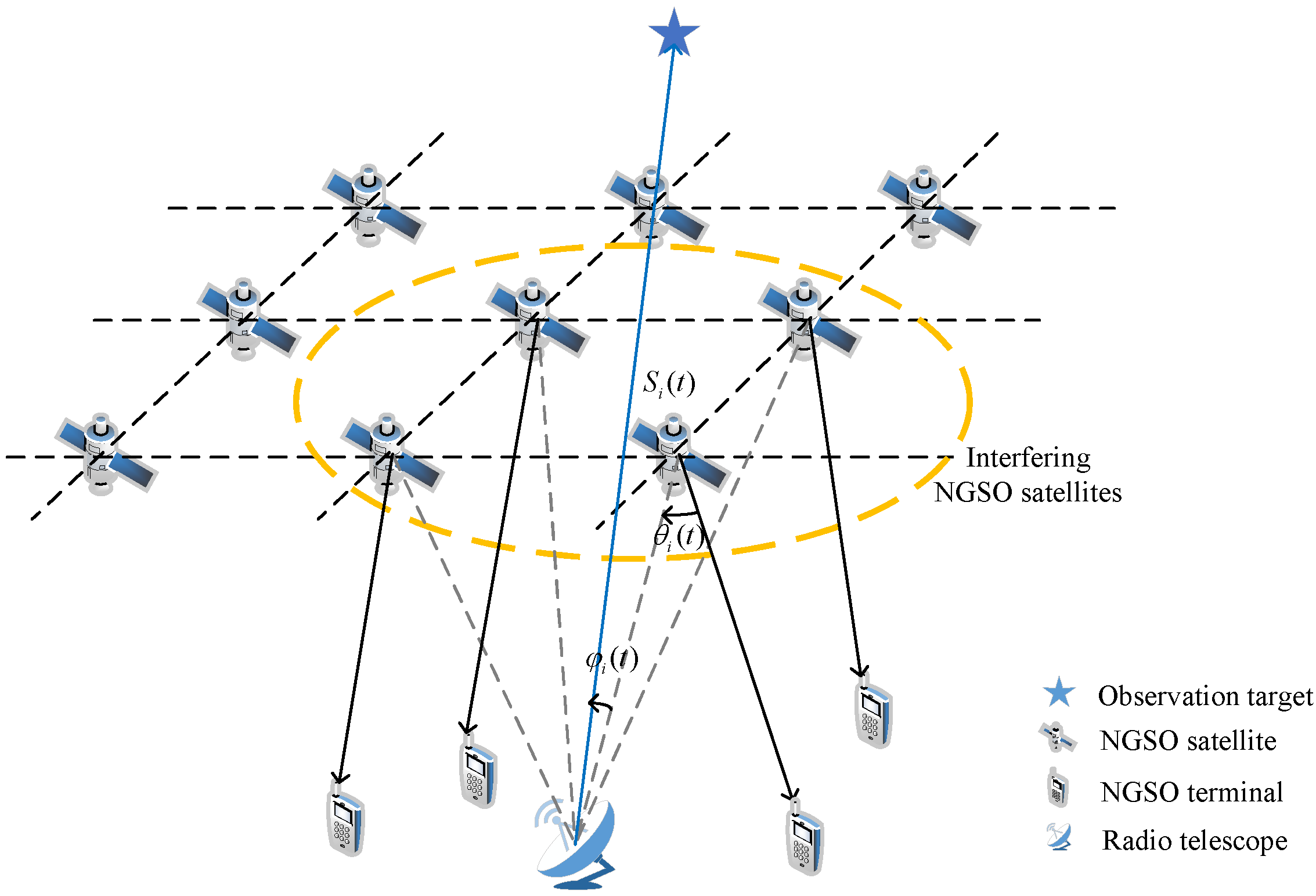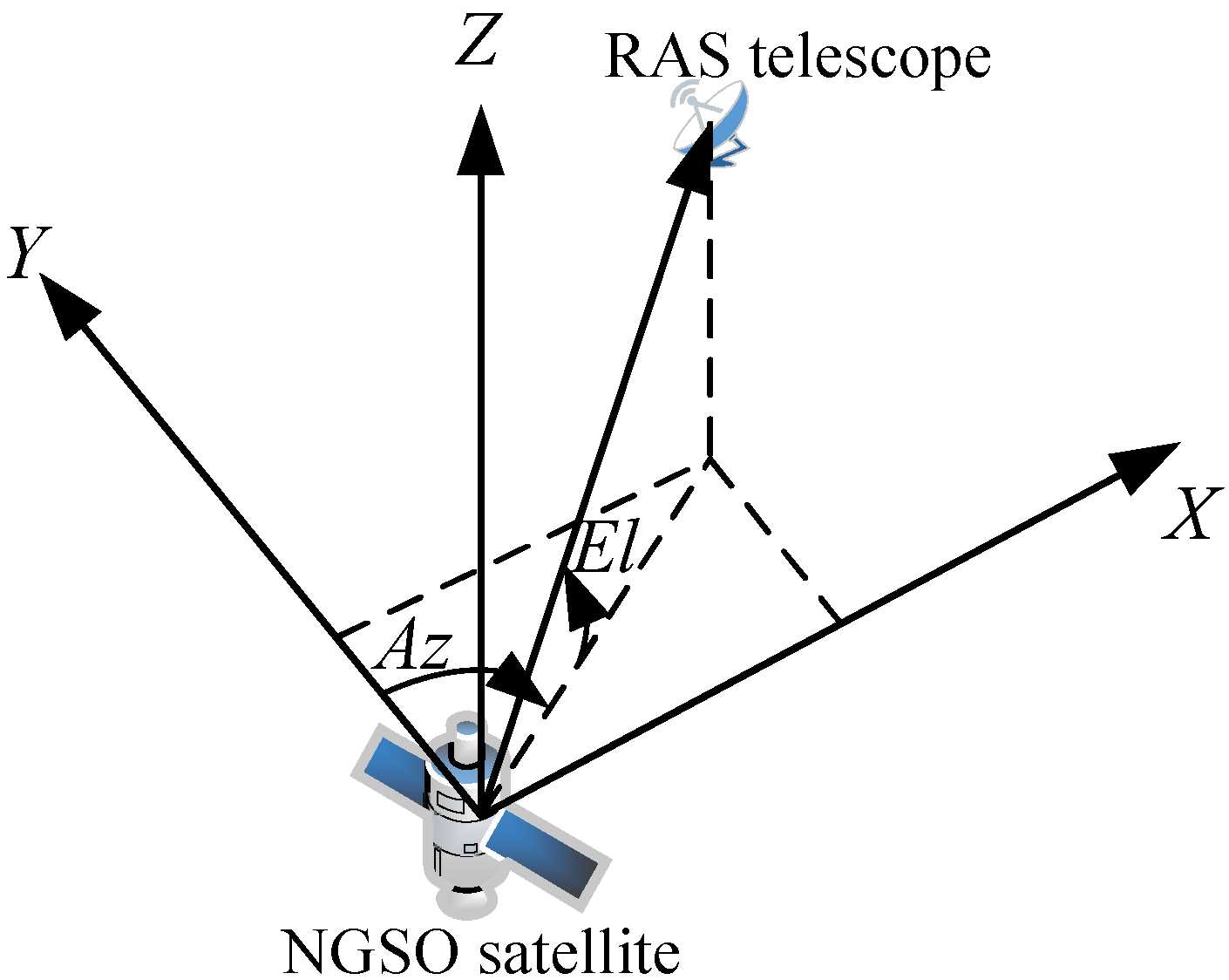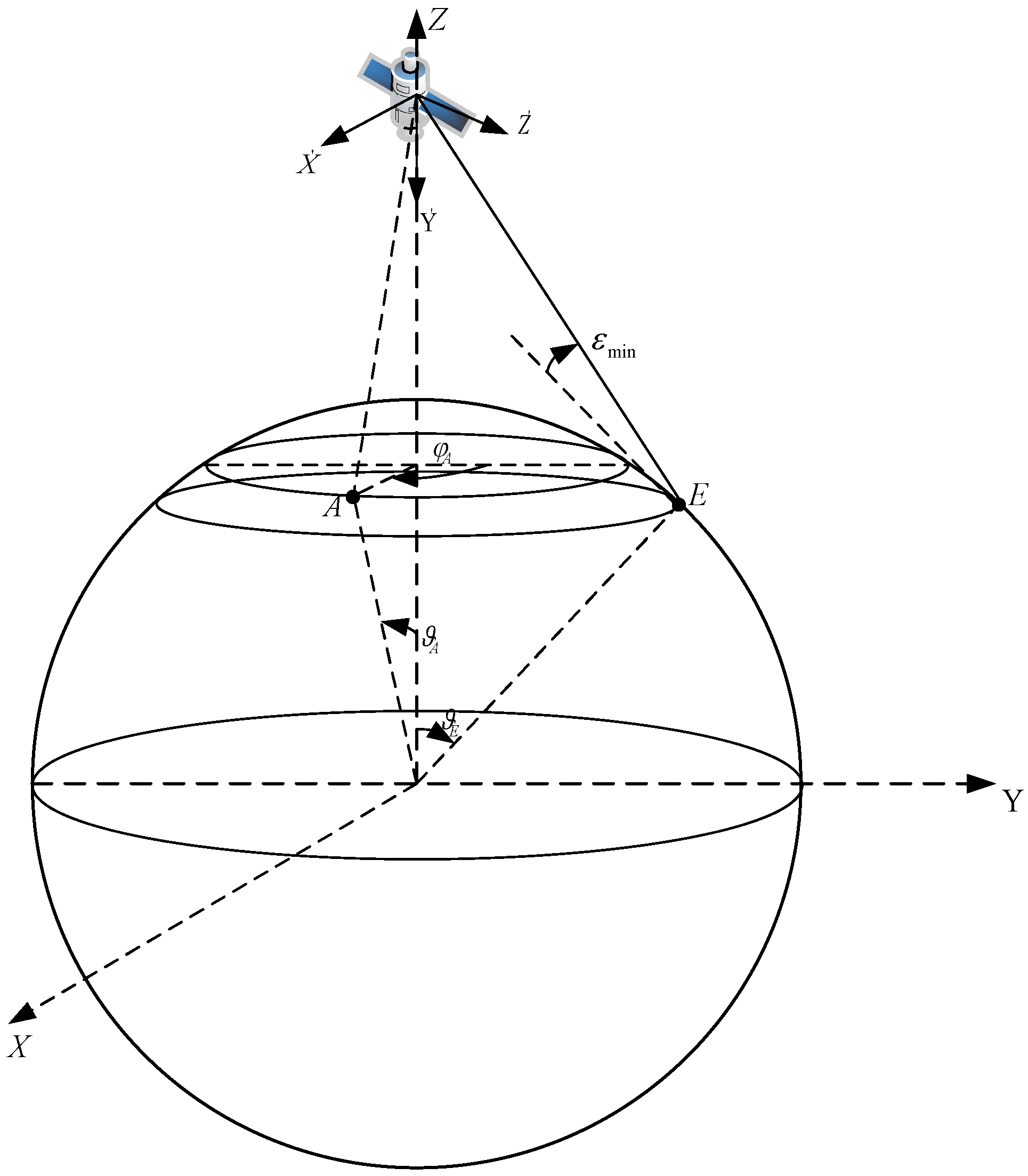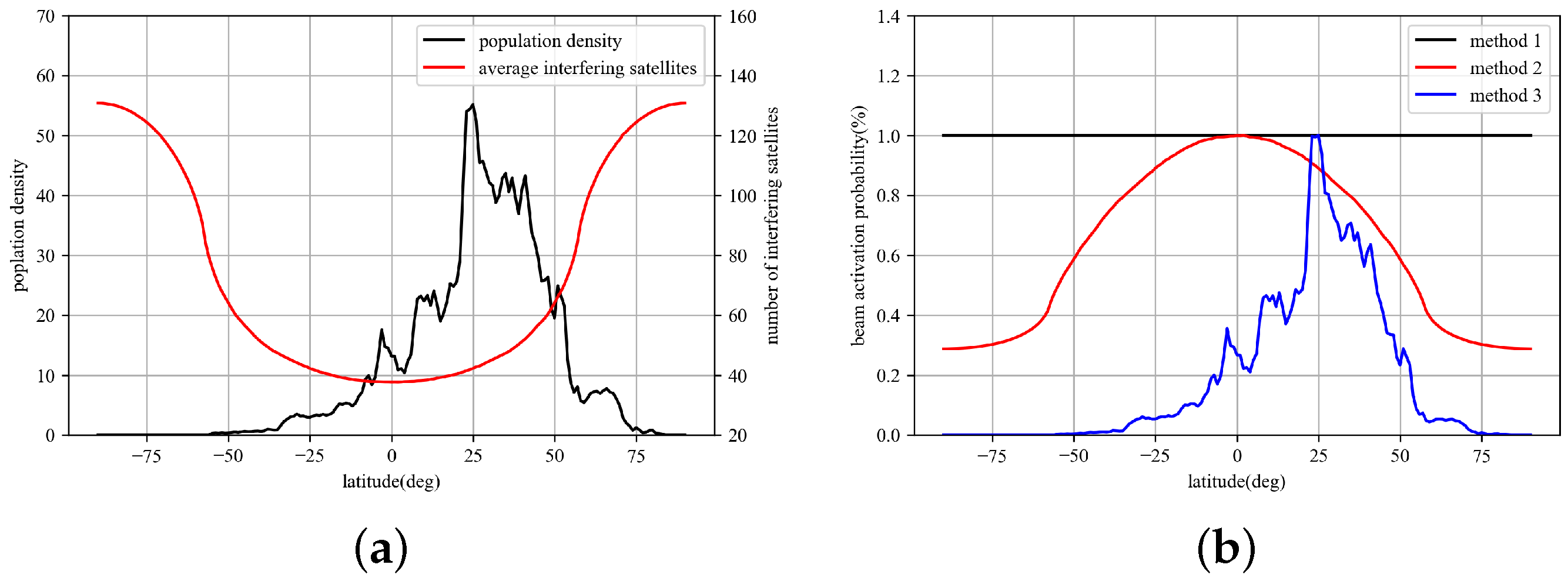A Framework for Assessing the Interference from NGSO Satellite Systems to a Radio Astronomy System
Abstract
:1. Introduction
- A method is proposed for characterizing interference in the RAS band by partitioning the field of view of the NGSO satellite into cells and selecting representative pointings for each cell, and then determining the probability distribution of the EIRP in each cell by sampling a large number of beam pointings according to the user distribution.
- The concept of beam activation probability is introduced to account for the fact that satellite beams are not always active, and three definitions of beam activation probabilities are provided.
- A new method for calculating the EPFD for RAS telescopes is proposed, which combines the probability density function of the EIRP in the field of view of the satellite with the activation probability of the satellite beams.
- A method for calculating the aggregate interference from multiple NGSO constellations to the RAS is presented. The aggregate EPFD at the RAS receiver is obtained by summing the EPFDs of individual NGSO systems, and the interference generated by different NGSO systems is assumed to be independent of each other. The aggregate EPFD probability density function can be expressed as the convolution of the EPFD probability density functions of the NGSO systems.
2. Model Description
2.1. EPFD at the RAS Telescope
2.2. Sky Division
2.2.1. Division of RAS
2.2.2. Division of Satellite
2.3. NGSO Satellite System Model
2.3.1. Constellation
2.3.2. Constraints
2.3.3. Satellite Antenna Pattern
2.3.4. Out-of-Band Emission
2.4. RAS Telescope Model
3. Framework of the Interference Analysis
3.1. Space–Time Distribution of Satellite EIRP
3.1.1. Generating the CDFs of EIRP
3.1.2. Generating the Beam Activation Probability
3.2. Beam Scheduling
3.3. EPFD Calculation Engine
- Determine the number of interfering satellites visible to the RAS receiver , calculate the elevation and azimuth of the RAS station relative to each satellite, where we denote the sets of interfering satellites, elevation and azimuth angles of RAS receiver, and interfering satellites as , , and , respectively. The distance between each satellite and the RAS station also needs to be counted, whose set is denoted as .
- For the satellite , , we need to determine in which cell in the satellite’s field of view the RAS station is located, and the expression for the expected EPFD for satellite at the cell of the RAS receiver is expressed as Equation (34), for :where is the latitude the subsatellite of satellite and is the off-axis angle between the satellite and the RAS observation within cell c. If and , equals to 1, otherwise it equals to 0.
- Based on the above steps, the total EPFD is denoted as below,Then, the average EPFD at cell c in a time interval with a start time can be expressed as the following:
3.4. Aggregate EPFD
4. Simulation Results
4.1. Simulation Parameters
4.2. CDFs of Satellite EIRP
4.3. Beam Activation Probability
4.4. EPFD of RAS Telescope
4.5. Aggregate EPFD
- Increase the guard band between the RAS band and the band of the NGSO satellite beams.
- Use filters with better cut-off characteristics and an amplifier with a better linearity to work in the linear region of amplification as far as possible.
- Adopt the interference avoidance zone of the RAS telescope, as well as a sharper roll-off antenna of the NGSO satellites.
5. Discussion and Conclusions
Author Contributions
Funding
Institutional Review Board Statement
Informed Consent Statement
Data Availability Statement
Conflicts of Interest
References
- Lin, X.; Cioni, S.; Charbit, G.; Chuberre, N.; Hellsten, S.; Boutillon, J. On the Path to 6G: Embracing the Next Wave of Low Earth Orbit Satellite Access. IEEE Commun. Mag. 2021, 12, 36–42. [Google Scholar] [CrossRef]
- Liu, S.; Gao, Z.; Wu, Y.; Ng, D.W.K.; Gao, X.; Wong, K.K.; Chatzinotas, S.; Ottersten, B. LEO satellite constellations for 5G and beyond: How will they reshape vertical domains? IEEE Commun. Mag. 2021, 59, 30–36. [Google Scholar] [CrossRef]
- Xie, H.; Zhan, Y.; Zeng, G.; Pan, X. LEO mega-constellations for 6G global coverage: Challenges and opportunities. IEEE Access 2021, 9, 164223–164244. [Google Scholar] [CrossRef]
- Kodheli, O.; Guidotti, A.; Vanelli-Coralli, A. Integration of Satellites in 5G through LEO Constellations. In Proceedings of the GLOBECOM 2017—2017 IEEE Global Communications Conference, Singapore, 4–8 December 2017; pp. 1–6. [Google Scholar]
- Su, Y.; Liu, Y.; Zhou, Y.; Yuan, J.; Cao, H.; Shi, J. Broadband LEO satellite communications: Architectures and key technologies. IEEE Wirel. Commun. 2019, 26, 55–61. [Google Scholar] [CrossRef]
- Oh, D.S.; Lee, S.M.; Ahn, D.S.; Kim, S. A study on the separation distance for frequency sharing between gso network and terrestrial network in Ka band. In Proceedings of the VTC Spring 2008—IEEE Vehicular Technology Conference, Singapore, 11–14 May 2008; pp. 2967–2971. [Google Scholar]
- Sharma, S.K.; Chatzinotas, S.; Ottersten, B. In-line interference mitigation techniques for spectral coexistence of GEO and NGEO satellites. Int. J. Satell. Commun. Netw. 2016, 34, 11–39. [Google Scholar] [CrossRef]
- Fan, Z.; Dai, Y.; Minn, H. Performance Analysis of Large-Scale NGSO Satellite-Based Radio Astronomy Systems. IEEE Access 2021, 9, 93954–93966. [Google Scholar] [CrossRef]
- Dai, Y.; Han, D.; Minn, H. Impacts of large-scale NGSO satellites: RFI and a new paradigm for satellite communications and radio astronomy systems. IEEE Tran. Conmmun. 2018, 67, 7840–7855. [Google Scholar] [CrossRef]
- Fan, Z.; Dai, Y.; Minn, H. RFI estimation from Non-GSO satellites based on two line element assisted equivalent power flux density calculations. In Proceedings of the 2018—International Symposium on Electromagnetic Compatibility (EMC EUROPE), Long Beach, CA, USA, 30 July–3 August 2018; pp. 17–21. [Google Scholar]
- Barnett, R.J. O3b Non-Geostationary Satellite System: Technical Information to Supplement Schedules—Attachment to Fcc Application sat-loi-20141029-00115; Technical Report SAT-LOI-20160428-00041; Federal Communications Commission: Washington, DC, USA, 2014.
- LeoSat. LeoSat Non-Geostationary Satellite System: Technical Information to Supplement Schedules—AttacLeoSathment to Fcc Application sat-PDR-20161115-00112; Technical Report SAT-PDR-20161115-00112; Federal Communications Commission: Washington, DC, USA, 2016.
- Mihai, A. Spacex Non-Geostationary Satellite System: Technical Information to Supplement Schedules—Attachment to Fcc Application sat-loa-20161115-00118; Technical Report SAT-LOA-20161115-00118; Federal Communications Commission: Washington, DC, USA, 2016.
- Barnett, R.J. OneWeb Non-Geostationary Satellite System: Technical Information to Supplement Schedules—Attachment to Fcc Application sat-loi-20160428-00041; Technical Report SAT-LOI-20160428-00041; Federal Communications Commission: Washington, DC, USA, 2016.
- Radio Regulations. 2020. Available online: https://www.itu.int/dms_pub/itu-r/opb/reg/R-REG-RR-2020-ZPF-E.zip (accessed on 1 December 2022).
- Umar, R.; Abidin, Z.; Ibrahim, Z.; Rosli, Z.; Noorazlan, N. Selection of radio astronomical observation sites and its dependence on human generated RFI. IOP Publ. Res. Astron. Astrophys. 2014, 14, 241. [Google Scholar] [CrossRef] [Green Version]
- Weber, R.; Faye, C.; Biraud, F.; Dansou, J. Spectral detector for interference time blanking using quantized correlator. Astron. Astrophys. Suppl. 1997, 126, 161–167. [Google Scholar] [CrossRef] [Green Version]
- Ford, J.M.; Buch, K.D. RFI mitigation techniques in radio astronomy. In Proceedings of the 2014 IEEE Geoscience and Remote Sensing Symposium, Quebec City, QC, Canada, 13–18 July 2014. [Google Scholar]
- Jeffs, B.D.; Li, L.; Warnick, K.F. Auxiliary Antenna-Assisted Interference Mitigation for Radio Astronomy Arrays. IEEE Trans. Signal Process. 2005, 53, 439–451. [Google Scholar] [CrossRef]
- Abdelgelil, M.E.; Minn, H. Non-linear interference cancellation for radio astronomy receivers with strong RFI. In Proceedings of the GLOBECOM 2017’2017 IEEE Global Communications Conference, Singapore, 4–8 December 2017. [Google Scholar]
- Protection Criteria Used for Radio Astronomical Measurements. 2003. Available online: https://www.itu.int/dms_pubrec/itu-r/rec/ra/R-REC-RA.769-2-200305-I!!PDF-E.pdf (accessed on 1 December 2022).
- Levels of Data Loss to Radio Astronomy Observations and Percentage-of-Time Criteria Resulting from Degradation by Interference for Frequency Bands Allocated to the Radio Astronomy Service on a Primary Basis. 2015. Available online: https://www.itu.int/dms_pubrec/itu-r/rec/ra/R-REC-RA.1513-2-201503-I!!PDF-E.pdf (accessed on 1 December 2022).
- Calculation of Unwanted Emission Levels Produced by a Non-Geostationary Fixed-Satellite Service System at Radio Astronomy Sites. 2003. Available online: https://www.itu.int/dms_pubrec/itu-r/rec/s/R-REC-S.1586-1-200701-I!!PDF-E.pdf (accessed on 1 December 2022).
- Reference Radio Astronomy Antenna Pattern to be Used for Compatibility Analyses between Non-GSO Systems and Radio Astronomy Service Stations Based on the Epfd Concept. Available online: https://www.itu.int/dms_pubrec/itu-r/rec/ra/R-REC-RA.1631-0-200305-I!!PDF-E.pdf (accessed on 1 December 2022).
- Maximum Permissible Levels of Interference in a Satellite Network (GSO/FSS; Non-GSO/FSS; Non-GSO/MSS Feeder Links) in the Fixed-Satellite Service Caused by Other Codirectional FSS Networks below 30 GHz. 2001. Available online: https://www.itu.int/dms_pubrec/itu-r/rec/s/R-REC-S.1323-2-200209-I!!PDF-E.pdf (accessed on 1 December 2022).
- Interference Calculations between Non-Geostationary Mobile-Satellite Service or Radionavigation-Satellite Service Systems and Radio Astronomy Telescope Sites. 2007. Available online: https://www.itu.int/dms_pubrec/itu-r/rec/m/R-REC-M.1583-1-200710-I!!PDF-E.pdf (accessed on 1 December 2022).
- Functional Description to Be Used in Developing Software Tools for Determining Conformity of Non-Geostationary-Satellite Orbit Fixed-Satellite Service Systems or Networks with Limits Contained in Article 22 of the Radio Regulations. 2018. Available online: https://www.itu.int/dms_pubrec/itu-r/rec/s/R-REC-S.1503-3-201801-I!!PDF-E.pdf (accessed on 1 December 2022).
- Maximum Permissible Levels of Interference in a Satellite Network (GSO/FSS; Non-GSO/FSS; Non-GSO/MSS Feeder Links) in the Fixed-Satellite Service Caused by Other Codirectional FSS Networks below 30 GHz. 2002. Available online: https://www.itu.int/dms_pubrec/itu-r/rec/s/R-REC-S.1528-0-200106-I!!PDF-E.pdf (accessed on 1 December 2022).












| Number of Satellites | Number of Planes | Orbit Inclination (deg) | Phase Factor | Range of RAAN (deg) |
|---|---|---|---|---|
| 720 | 18 | 90 | 9 | 0∼180 |
| Parameter | Value | Unit |
|---|---|---|
| Orbit height of NGSO satellite | 1200 | km |
| Orbit height of GSO satellite | 35,678 | km |
| Radius of the Earth | 6371 | km |
| Bandwidth of satellite beam | 250 | MHz |
| EIRP | 34.6 | dBW |
| Centre frequency | 10.725 | GHz |
| Diameter of satellite antenna | 0.4 | m |
| Max gain of satellite antenna | 32 | dBi |
| GSO arc avoidance angle | 18 | deg |
| Minimum frequency of RAS telescope | 10.6 | GHz |
| Maximum frequency of RAS telescope | 10.7 | GHz |
| EPFD threshold | −160 | dBW/m/100 MHz |
| Allowable probability of exceeding EPFD threshold | - |
| Number of Satellites | Number of Planes | Orbit Inclination (deg) | Phase Factor | Range of RAAN (deg) |
|---|---|---|---|---|
| 1296 | 36 | 90 | 18 | 0∼180 |
| Directions of RAS | Direction 1 | Direction 2 | Direction 3 |
|---|---|---|---|
| Elevation angle (deg) | 1.5 | 31.5 | 61.5 |
| Azimuth angle (deg) | 1.5 | 1.73 | 2.95 |
| Configuration | Constellation of 720 | Constellation of 1296 | Constellation of 720 + 1296 |
|---|---|---|---|
| EPFD of direction 1 (dBW/100 MHz/m) | −132.15 | −128.62 | −127.10 |
| EPFD of direction 2 (dBW/100 MHz/m) | −131.73 | −124.22 | −123.26 |
| EPFD of direction 3 (dBW/100 MHz/m) | −131.22 | −122.15 | −120.80 |
Disclaimer/Publisher’s Note: The statements, opinions and data contained in all publications are solely those of the individual author(s) and contributor(s) and not of MDPI and/or the editor(s). MDPI and/or the editor(s) disclaim responsibility for any injury to people or property resulting from any ideas, methods, instructions or products referred to in the content. |
© 2023 by the authors. Licensee MDPI, Basel, Switzerland. This article is an open access article distributed under the terms and conditions of the Creative Commons Attribution (CC BY) license (https://creativecommons.org/licenses/by/4.0/).
Share and Cite
Zou, C.; Wang, H.; Xia, S.; Chang, J.; Shao, F.; Shang, L.; Hu, Y.; Li, G. A Framework for Assessing the Interference from NGSO Satellite Systems to a Radio Astronomy System. Appl. Sci. 2023, 13, 1691. https://doi.org/10.3390/app13031691
Zou C, Wang H, Xia S, Chang J, Shao F, Shang L, Hu Y, Li G. A Framework for Assessing the Interference from NGSO Satellite Systems to a Radio Astronomy System. Applied Sciences. 2023; 13(3):1691. https://doi.org/10.3390/app13031691
Chicago/Turabian StyleZou, Cheng, Haiwang Wang, Shiyi Xia, Jiachao Chang, Fengwei Shao, Lin Shang, Yuemei Hu, and Guotong Li. 2023. "A Framework for Assessing the Interference from NGSO Satellite Systems to a Radio Astronomy System" Applied Sciences 13, no. 3: 1691. https://doi.org/10.3390/app13031691








